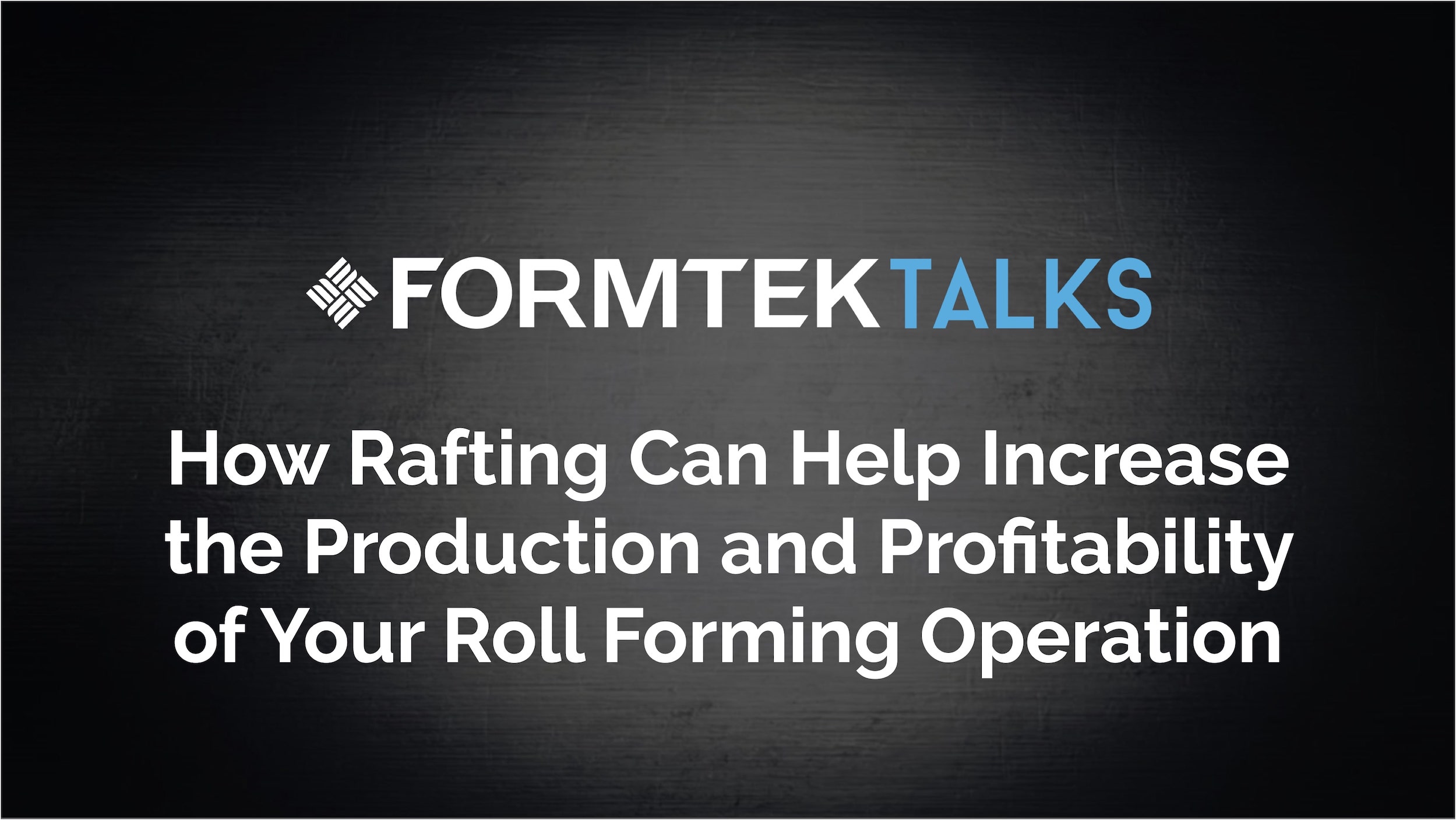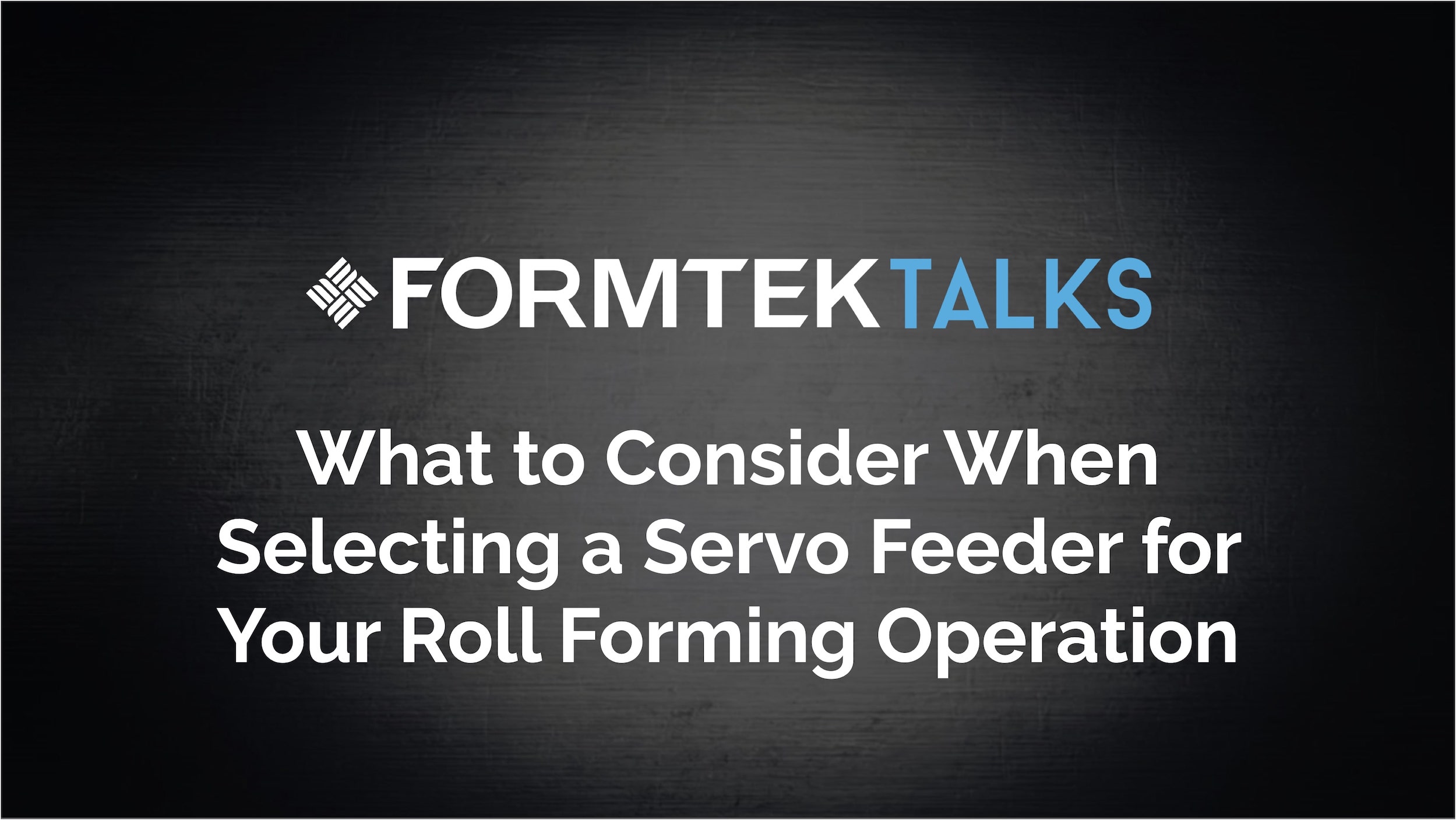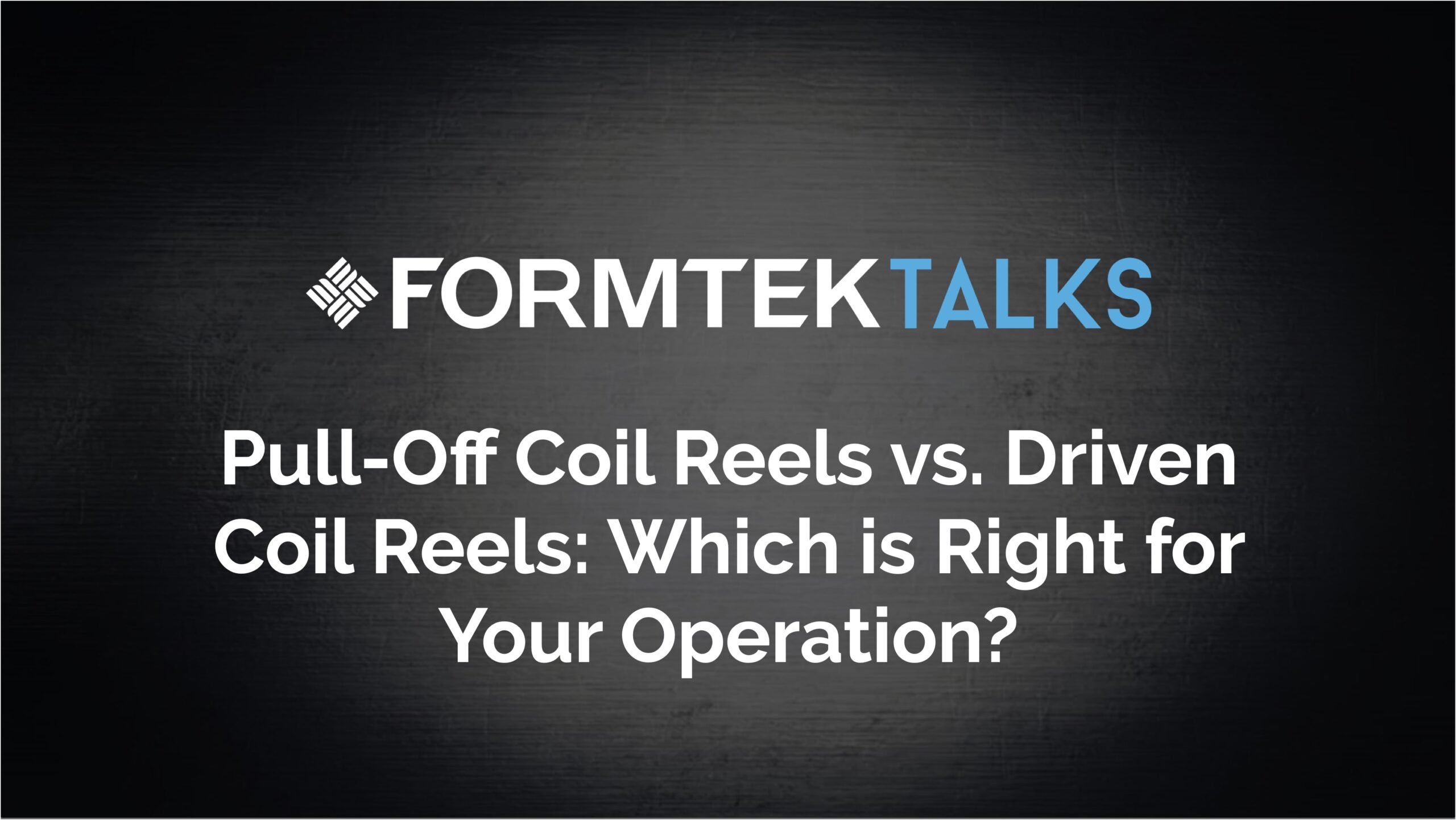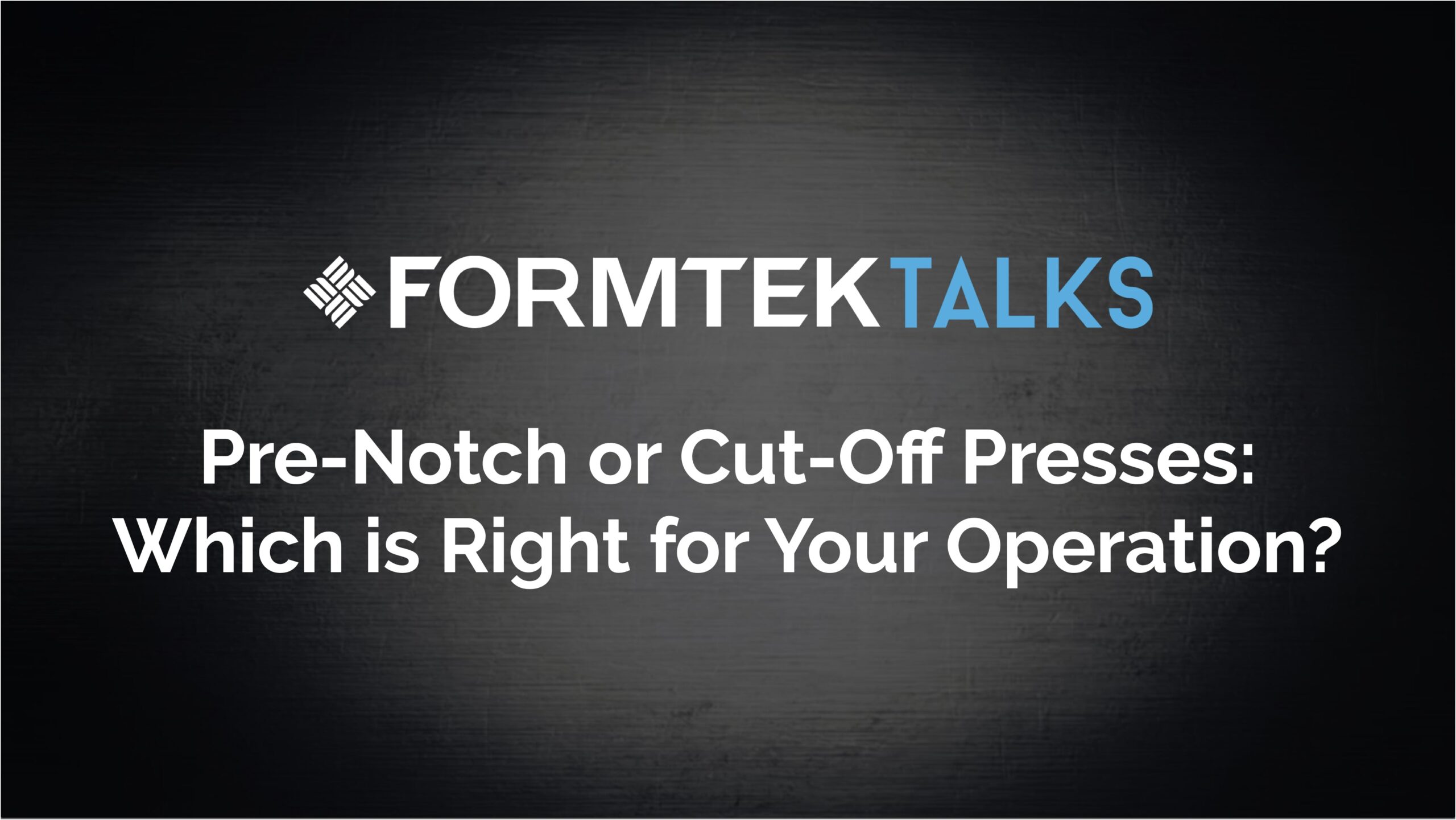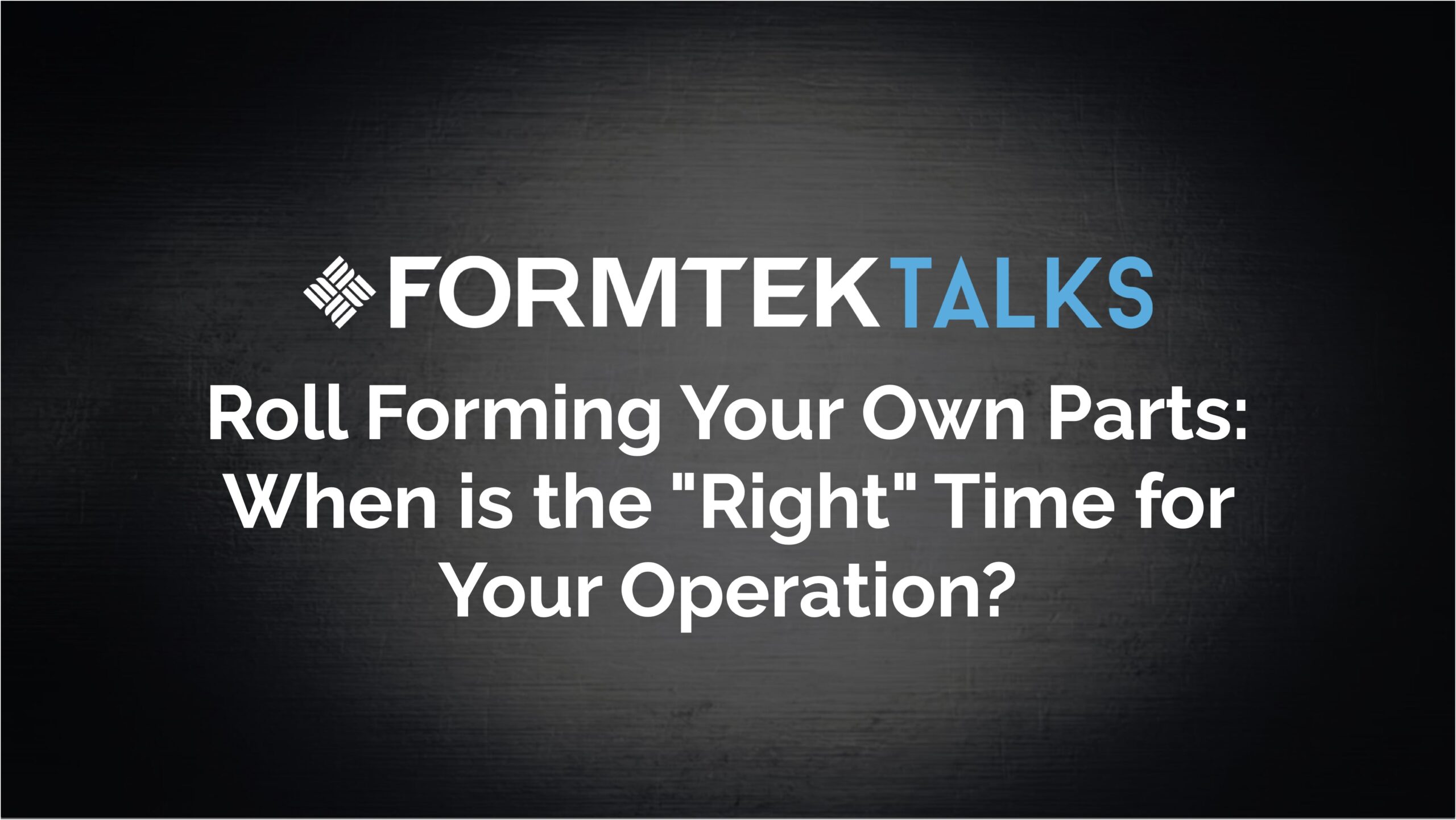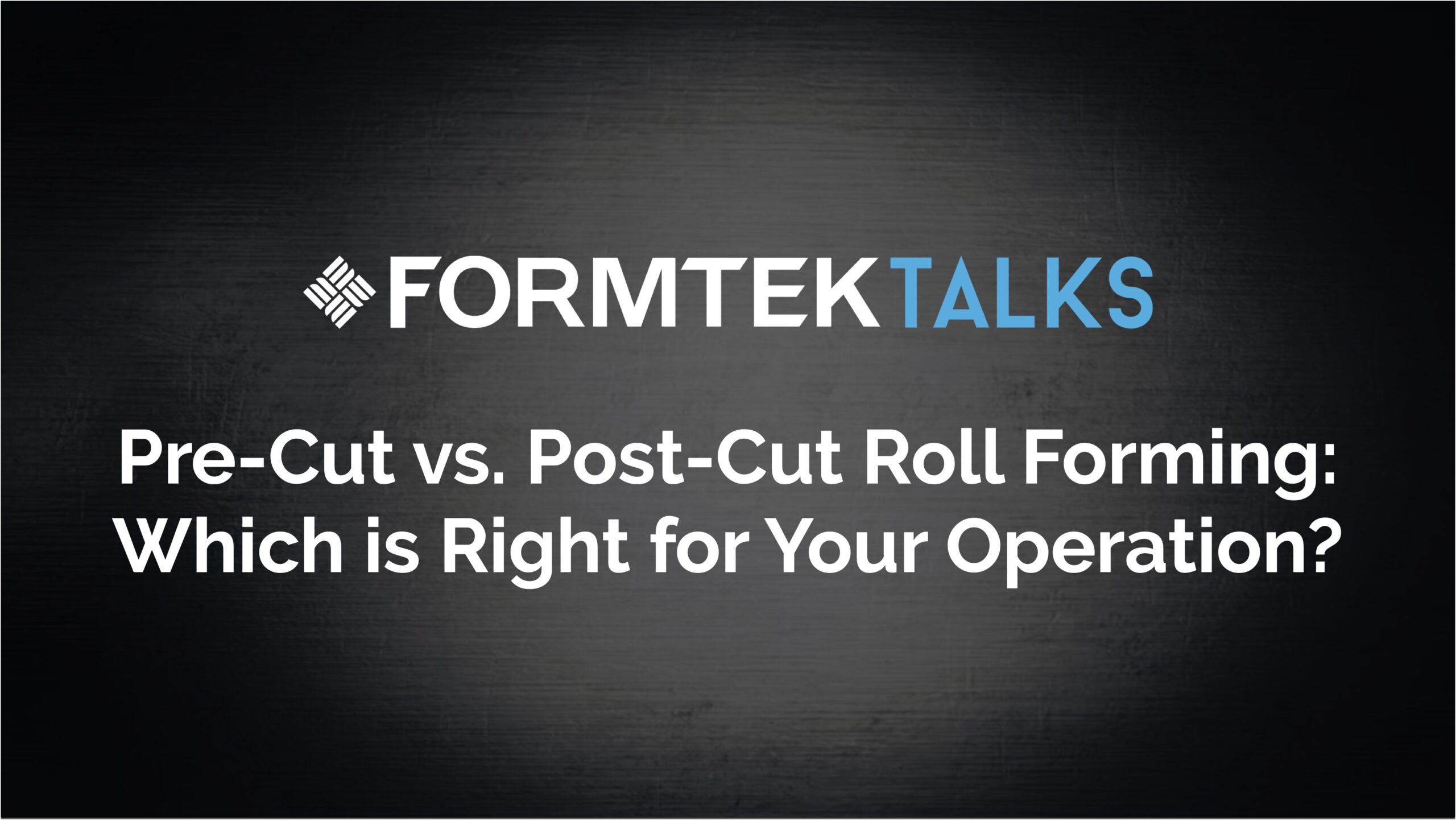Welcome to Formtek Talks — where we discuss the topics that matter most to the metal forming and fabrication industry as you look for ways to improve your operations.
In this episode, Brian Kopack is joined by Kevin Enos, and Charlie Burgess and the discussion focuses on straighteners. We get into things like “do you really need one?” and “how you should size it?” and even talk a bit about looping pits. Basically the things you may want to consider when you’re making the decision adding a straightener to your operation. As you’ll see, there are a number of things to consider in deciding IF adding straightener is right for your operation and then which type of straightener may be right for you. But that’s why Formtek is here to help as you make these evaluations. So when you’re ready, please don’t hesitate to reach out for a no-obligation, 1-on-1 consultation with a Formtek Technical Specialist — we’d love to get to know you and your operation, get a good understanding of what you’re looking to do, and see how we can help you achieve your objectives.
Meet the Panelists
Watch the Video
Listen to the Podcast
Read the Transcript

We Want Your Feedback
We’d love to hear what you think about Formtek Talks so we can make these better as we go along. Even feedback about what topics you’d like to see us tackle in future episodes would be great.
Meet the Panelists

Brian Kopack
Vice President of Sales | Formtek, Inc.
- 22 years in the metal forming and manufacturing industry
- Bachelor of Science Degree | Mechanical Engineering from Case Western Reserve University

Kevin Enos
Vice President of Sales - Midwest | Formtek, Inc.
- Over 25 years in the metal forming and manufacturing industry
- Bachelor of Science Degree – Business Management | Edison State College

Charlie Burgess
Sales & Application Engineer | Formtek, Inc.
- Over 30 years in the metal forming and manufacturing industry
- Bachelor of Science Degree | Mechanical Engineering from Youngstown State University
Watch the Video
Listen to the Podcast
Read the Transcript
Well, primarily if it’s coming in coiled, you’re putting it on a mandrel, you’re going to get coil set in that material. So traditionally, you want to have a straightener and as a part of a line to remove coil set. That is all a straightener is designed to remove. If you’ve got other coil conditions other than coil set, that’s going to get you into a leveler. So oil canning, things of that nature are going to be addressed with other pieces of equipment other than a straightener. And based on the application those are going to come in a number of different formats.
Those could be seven roll, nine roll, 11, all the way up to 21 roll, what we would consider a precision straightener. So some applications are going to require an extra amount of flatness. So a motor stater for example, has to be completely flat in order for the efficiencies of the motor that’s ultimately going to be made from that to be as energy efficient as possible. You can have those in configurations again, up to a half inch in thickness, up to 84 inches in width. And if you’ve got material again, that’s not cold rolled or mild steel, and you’re going to get into more HSLA type materials, you definitely have to have a straightener for that type of an application.
That’s going to again, remove the coil set before the material gets introduced to a secondary piece of equipment or a loop. Then you can also have combinations of that as well. So a feeder straightener, a straightener with a pull-through feeder and different combinations for space saving purposes would also comprise of a straighteners application.
They are primarily application driven, and I’ll say application, but the customer is typically the one specifying that. And it’s a combination, what we call a combination unit, a feeder with a pull-through straightener. As an example is a usually a space consideration. So that’s a customer driven. In every other respect, a driven straightener is typically always the best way to go because again, you’re going to want to work that material. A pull-through straightener is not going to be effective once you start getting into thicker, heavier gauge materials, wider materials, the friction involved, et cetera.
Line speed is going to be a factor in that. You would not want for example, a pull-through straightener in a surface critical application. Again, the purpose of the feeder is to start and stop. The purpose of a straightener is really you want that going on a continuous basis with a combination unit. When you’re and stopping, you have the pull-through straightening rolls in contact with the material at all times. And as a result of that, there’s an increased chance you’re going to mark or scratch that material.
I do not. Although, you guys can speak better to the impact on a roll forming. It is my belief and certainly as a manufacturer on the straightener side of it, that from the beginning of a coil through the end of a coil, it all needs to be straightened or flattened as some people call it. I would assume in part, when you’re first starting a coil, you have where it’s been cut, you may have more of a severe downturn to that you have to upturn at the end of the coil as you’re bringing that to completion. You’re going to have a tighter wrap and a tighter ID in that location. So again, the coil set is going to be greater as you reduce the size of the coil and near the end of it.
So hence, it’s important at the beginning and the end for those reasons. But in most instances it’s important all the way throughout. In addition, you’ll see changes in the coil from start to finish. It’s just the nature of the way the coils are made. So from that perspective, it’s definitely beneficial to do it from start to finish. I would think from a roll forming standpoint, that the roll forming stations are also working the material to one degree or another. So that may be why there’s a difference between a stamping application and a roll forming application.
My professional opinion on that is yes. Again, nowadays it isn’t just a matter of the thickness of material. The yield is a big factor in that. And as you get into the different roll diameters, so the number of rolls is only one factor in that the roll diameters are another factor. So for thin gauge material, it may actually require more of a precision leveler to better work that thinner gauge material and the centering of those rolls are another factor in that as well. A couple of other things you get into are roll adjustability.
So we have what’s called a bank adjust, which is all of the upper level rolls are adjusted as a bank or as one, versus individual roll adjustment. So a seven or a nine roll straightener, you have the ability to have individual roll adjustment of your top work rolls. In a 19 roll that is going to be a bank adjust on a leveler, it’s going to be a bank adjust. And that has more to do with the operators, maintenance personnel to a lesser extent. But if you allow an operator to have the ability to individually adjust 19 work rolls, you could end up with all kinds of variations in your product.
No, that’s a great question. Most of what is sold is nowadays is got a chrome finish on it. The biggest advantage to that is it discourages picking up materials, contaminants, and sticking to those rolls and imparting those same materials on to the material. So it’s definitely advantageous for the high chrome or chrome finish on a roll to lessen the amount or mitigate the amount of contaminants that may get drug into the roll forming tooling or the press tooling where serious damage and money expense could be incurred. The other variations have more to do with the pinch rolls as you get into the types of materials on the pin rolls for the same reason as far as not marking.
And typically on a straightener, you’re going to have a set of entry and a set of exit pinch rolls. Those are going to be of a different material typically than your work rolls. And it’s again, because you’re gripping and pulling typically on the entry end and then pushing on the exit end differently than you are when you’re straightening and working the material.
That is correct. There’s a couple of benefits. Again, the vast majority, probably 90% of the straighteners we manufacture are an inclined head. And the advantage there is primarily you are taking material off of a coil, and for this conversation we’ll assume it’s a 72 inch coil. The payoff point where that materials coming off to enter into the straightener head, it’s advantageous for that incline head as the material with gravity wants to go that direction. As you deplete that coil, it helps maintain that you don’t have such a drastic change in direction from that larger coil to a flat head cabinet.
Where again, you may introduce some damage to that material. Faster speeds, if there’s a loop that proceeds the straightener itself, again, to minimize the radius going into that loop, having that the end or the exit of that straightener in that incline position negates the potential for reintroducing coil set into that material. You’ll typically find them more in higher speed applications than you will a flat type of straightener. The flat type of straightener is like I said, at this point, less than 10% of the overall market, because it’s more niche oriented than it is a commodity, if you will, in regards to how it’s utilized in the field.
There’s a couple of different thoughts on that. Certainly a pit is best case scenario because it gives you the most excess material again, for allowing the machinery to operate continuously and not starting and stopping. The feeder is the only thing that’s really designed to start and stop on a regular basis. And raising the equipment pass line heights can gain you a little bit of additional looping area. Simply stretching out the material, it can help a little bit, but you really don’t get any additional feed lengths or additional speed in that configuration.
The other concern is again, the amount material you have be it in a pit or in elongated configuration is, that is weight that the feeder is having to pull out of that pit. So by far and away, a in-ground pit is the best way to go, raising the pass line would be your second best alternative. Your last alternative is stretching out the material, or the length of the line because there’s very little to be gained. There are various types of aboveground types of looping, an S-Loop would be an example where you’re bringing that material, this is for thinner gauge narrow material typically, you’re bringing that material out again, typically with an inclined head on the straightener into an S-Loop configuration that goes up vertically.
And your exit is of a higher pass line into your next piece of equipment, but that would be the fourth alternative to gaining additional material into a line.
Yeah. I’ve seen quite a few of the vertical and horizontal. In fact, one of your major product lines in tube mills, I think horizontal accumulators are kind of common where you have a car that’s got a wheel, or I should say an idler wheel on it that travels horizontally. And as the front end is overfilling it, it’s traveling and accumulating all that strip. And when the process starts back up again, then the car goes back in the other direction and lets material out of it. But vertical accumulators were quite common in one of the industries I was in. But you were looking at a lot of accumulation. They were looking for two minutes of accumulation to do a weld cycle for instance.
When we run into that too much in roll forming, although you do get weld applications in roll forming for tube mills, for instance, and even some of the more traditional lines. But they’re usually fairly fast, your cycle time for the weld is not as much as you would get in a steel mill where you’re trying to weld 46 inch wide material, you’re welding 13 inch wide material and 12 inch wide material. Haven’t seen a whole lot of verticals or horizontal other than that tube mill application in roll forming. But I know a lot of people don’t like pits.
And as we talked earlier, we saw a few people that made like the three roll verticals, we just had a single roll that traveled vertically, and you had two strands of accumulation, and you could get 25 feet of accumulation.
I think it’s also a difference and it could be nomenclature, but an accumulator versus a loop serve two different purposes. Typically, the accumulator is to allow a continuous run even when you’re processing a changeover. In the case of a looping pit, or vertical or otherwise, it’s more a matter of again, just keeping the machinery going forward on a continuous basis and not to accumulate enough material that you could continue to run through a coil changeover. So I think there’s a big difference again, as the nomenclature people use words interchangeably.
And I don’t think that that’s always effective obviously on an application basis where somebody could be asking for an accumulator, but in reality what they really mean is something else.
It’s interesting you said that. Because when we were looking for those single roll vertical accumulators, what I found out was when I put in vertical accumulator, I got some hits. And then I put in festoon accumulator, and a whole another selection of equipment came up. And basically the same principle, but the shape of the material in that type of accumulators is like a festoon, just zigzags up and down. But it’s all how people name or what kind of nomenclature they want to use. You really do limit yourself, and you got to use a wide variety of terms if you’re trying to find something out there in the marketplace, or you may miss it all together.
I got very few hits on vertical accumulator, but when I put the festoon in, that’s where most of those results came that I sent you for that application you had.
Well thank you two very much…
So hopefully our discussion on straightener was helpful to you. As you can see, there’s definitely a number of things to consider in deciding if a straightener is right for your operation. And then which type of straightener is right for you. Of course, please know that we’re here to help as you make these evaluations.
Please don’t hesitate to reach out for a consultation, the best to do so is through our website at formtekgroup.com. And there’s absolutely no obligation. We’d love to understand what you’re looking to do and see how we can help you achieve your objectives. For now, thanks again for listening. On behalf of Kevin Enos and Charlie Burgess I’m Brian Kopack. Join us again for the next to Formtek Talks.




